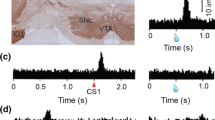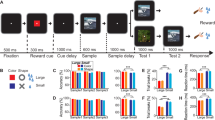Abstract
The prefrontal cortex (PFC) is thought to be involved in higher order cognitive functions, such as in working memory, abstract categorization, and reward processing. It has been reported that two distinct neuron classes (putative pyramidal cells and interneurons) in the PFC played different functional roles in neural circuits involved in forming working memory and abstract categories. However, it remains elusive how the two types of neurons process reward information in the PFC. To investigate this issue, the activity of single neurons was extracellularly recorded in the PFC of the monkey performing a reward predicting task. PFC neurons were classified into putative pyramidal cells and interneurons, respectively, based on the waveforms of action potentials. Both the two types of neurons encoded reward information and discriminated two reward conditions (the preferred reward condition vs. the nonpreferred reward condition). However, the putative pyramidal neurons had better and more reliable discriminability than the putative interneurons. Also, the pyramidal cells represented reward information in the preferred reward condition, but not in the nonpreferred reward condition by raising their firing rates relative to the baseline rates. In contrast, the interneurons encoded reward information in the nonpreferred reward condition, but not in the preferred reward condition by inhibiting their discharge rates relative to the baseline rates. These results suggested that the putative pyramidal cells and interneurons had complementary functions in reward processing. These findings may help to clarify individual functions of each type of neurons in PFC neuronal circuits involved in reward processing.
Similar content being viewed by others
References
Contreras D. Electrophysiological classes of neocortical neurons. Neural Netw, 2004, 17: 633–646
Markram H, Toledo-Rodriguez M, Wang Y, et al. Interneurons of the neocortical inhibitory system. Nat Rev Neurosci, 2004, 5: 793–907
Wonders C P, Anderson S A. The origin and specification of cortical interneurons. Nat Rev Neurosci, 2006, 7: 687–696
White E L. Cortical Circuits: Synaptic Organization of the Cerebral Cortex. Boston: Birkhauser, 1989
Peters A, Jones E G. Cellular Components of the Cerebral Cortex. New York: Plenum, 1984
Connors B W, Gutnick M J. Intrinsic firing patterns of diverse neocortical neurons. Trends Neurosci, 1990, 13: 99–104
Henze D A, Borhegyi Z, Csicsvari J, et al. Intracellular features predicted by extracellular recordings in the hippocampus in vivo. J Neurophysiol, 2000, 84: 390–400
Gold C, Henze D A, Koch C, et al. On the origin of the extracellular action potential waveform: a modeling study. J Neurophysiol, 2006, 95: 3113–3128
Nowak L G, Sanchez-Vives M V, McCormick D A. Lack of orientation and direction selectivity in a subgroup of fast-spiking inhibitory interneurons: cellular and synaptic mechanisms and comparison with other electrophysiological cell types. Cereb Cortex, 2008, 18: 1058–1078
Atencio C A, Schreiner C E. Spectrotemporal processing differences between auditory cortical fast-spiking and regular-spiking neurons. J Neurosci, 2008, 28: 3897–3910
Swadlow H A, Gusev A G. Receptive-field construction in cortical inhibitory interneurons. Nat Neurosci, 2002, 5: 403–404
Mitchell J F, Sundberg K A, Reynolds J H. Differential attention dependent response modulation across cell classes in macaque visual area V4. Neuron, 2007, 55: 131–141
Kvitsiani D, Ranade S, Hangya B, et al. Distinct behavioural and network correlates of two interneuron types in prefrontal cortex. Nature, 2013, 498: 363–366
Constantinidis C, Goldman-Rakic P S. Correlated discharges among putative pyramidal neurons and interneurons in the primate prefrontal cortex. J Neurophysiol, 2002, 88: 3487–3497
Diester I, Nieder A. Complementary contributions of prefrontal neurons classes in abstract numerical categorization. J Neurosci, 2008, 28: 7737–7747
Miller E K, Cohen J D. An integrative theory of prefrontal cortex function. Annu Rev Neurosci, 2001, 24: 167–202
Rigotti M, Barak O, Warden M R, et al. The importance of mixed selectivity in complex cognitive tasks. Nature, 2013, 497: 585–590
Pan X, Sakagami M. Category representation and generalization in the prefrontal cortex. Eur J Neurosci, 2012, 35: 1083–1091
Bongard S, Nieder A. Basic mathematical rules are encoded by primate prefrontal cortex neurons. Proc Natl Acad Sci USA, 2010, 107: 2277–2282
Rao S G, Williams G V, Goldman-Rakic P S. Isodirectional tuning of adjacent interneurons and pyramidal cells during working memory: evidence for microcolumnar organization in PFC. J Neurophysiol, 1999, 81: 1903–1916
Rao S G, Williams G V, Goldman-Rakic P S. Destruction and creation of spatial tuning by disinhibition: GABA(A) blockade of prefrontal cortical neurons engaged by working memory. J Neurosci, 2000, 20: 485–494
Constantinidis C, Williams G V, Goldman-Rakic P S. A role for inhibition in shaping the temporal flow of information in prefrontal cortex. Nat Neurosci, 2002, 5: 175–180
Watanabe M. Reward expectancy in primate prefrontal neurons. Nature, 1996, 382: 629–632
Leon M I, Shadlen M N. Effect of expected reward magnitude on the response of neurons in the dorsolateral prefrontal cortex of the macaque. Neuron, 1999, 24: 415–425
Kobayashi S, Lauwereyns J, Koizumi M, et al. Influence of reward expectation on visuospatial processing in macaque lateral prefrontal cortex. J Neurophysiol, 2002, 87: 1488–1498
Roesch M R, Olson C R. Impact of expected reward on neuronal activity in prefrontal cortex, frontal and supplementary eye fields and premotor cortex. J Neurophysiol, 2003, 90: 1766–1789
Pan X, Sawa K, Tsuda I, et al. Reward prediction based on stimulus categorization in primate lateral prefrontal cortex. Nat Neurosci, 2008, 11: 703–712
Ma C F, Pan X, Wang R B, et al. Estimating causal interaction between prefrontal cortex and striatum by transfer entropy. Cogn Neurodyn, 2013, 7: 253–261
Swadlow H A. Fast-spike interneurons and feedforward inhibition in awake sensory neocortex. Cereb Cortex, 2003, 13: 25–32
Homayoun H, Moghaddam B. NMDA receptor hypofunction produces opposite effects on prefrontal cortex interneurons and pyramidal neurons. J Neurosci, 2007, 27: 11496–11500
Kawaguchi Y. Physiological subgroups of nonpyramidal cells with specific morphological characteristics in layer II/III of rat frontal cortex. J Neurosci, 1995, 15: 2638–2655
Gabbott P L, Bacon S J. Local circuit neurons in the medial prefrontal cortex (areas 24 a,b,c, 25 and 32) in the monkey: II. Quantitative areal and laminar distributions. J Comp Neurol, 1996, 364: 609–636
Mann E O, Paulsen O. Role of GABAergic inhibition in hippocampal network oscillations. Trends Neurosci, 2007, 30: 343–349
Povysheva N V, Gonzalez-Burgos G, Zaitsev A V, et al. Properties of excitatory synaptic responses in fast-spiking interneurons and pyramidal cells from monkey and rat prefrontal cortex. Cereb Cortex, 2006, 16: 541–552
Goldman-Rakic P S. The prefrontal landscape: Implications of functional architecture for understanding human mentation and the central executive. Philos Trans R Soc Lond B Biol Sci, 1996, 351: 1445–1453
Takada K, Funahashi N. Prefrontal task-related activity representing visual cue location or saccade direction in spatial working memory tasks. J Neurophysiol, 2002, 87: 567–588
Araki O. Computer simulations of synchrony and oscillations evoked by two coherent inputs. Cogn Neurodyn, 2013, 7: 133–141
Li Y T, Tsuda I. Novelty-induced memory transmission between two nonequilibrium neural networks. Cogn Neurodyn, 2013, 7: 225–236
Du Y, Wang R B, Han F, et al. Firing pattern and synchronization property analysis in a network model of the olfactory bulb. Cogn Neurodyn, 2012, 6: 203–209
Author information
Authors and Affiliations
Corresponding author
Rights and permissions
About this article
Cite this article
Pan, X., Fan, H., Wang, R. et al. Contributions of distinct prefrontal neuron classes in reward processing. Sci. China Technol. Sci. 57, 1257–1268 (2014). https://doi.org/10.1007/s11431-014-5561-x
Received:
Accepted:
Published:
Issue Date:
DOI: https://doi.org/10.1007/s11431-014-5561-x




